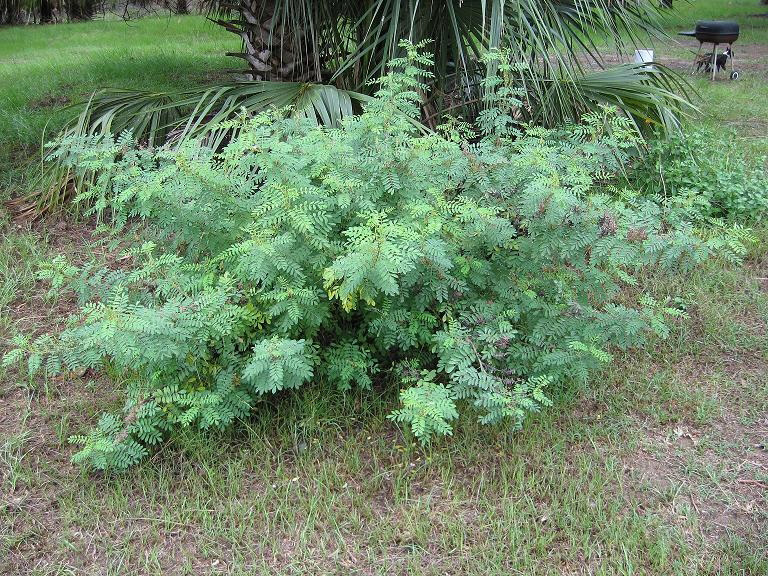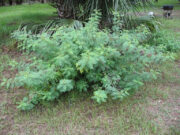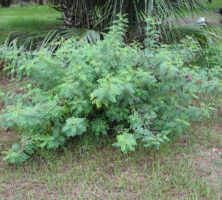Humans have held the color blue, often symbolizing power, authority, and even the divine, in high regard for thousands of years. When England began colonizing the New World in the seventeenth and eighteenth centuries, it became evident that the success of a colony depended on its ability to produce a valuable and marketable export commodity. Planters in the colony of Georgia profited greatly when they were able to supplement their booming rice and timber exports with indigo, the highly prized source of blue dye.

Photograph by James Bitler
The Botany of Blue
Prior to 1897, when synthesized indigo became available in the marketplace for the first time, the most common source of blue dye came from plants. Woad (Isatis tinctoria) is native to most of Europe, where it was widely cultivated for use as a dye. By the late seventeenth century, however, plants of the genus Indigofera, known as indigo, provided a stronger, richer blue and replaced woad blue in Western Europe.
The genus Indigofera comprises more than 700 species, two of which were popular as a dye source: I. tinctoria, native to Asia, and I. suffruticosa, native to Central and South America. Although the Asian variety was considered by some to be finer, planters in South Carolina, Georgia, and Florida cultivated the New World variety extensively, perhaps due to similar climate. I. suffruticosa still grows wild on the north end of Georgia’s Ossabaw Island at North End Plantation, the site of a colonial-era indigo plantation.
The Economics of Indigo
In the mid–seventeenth century Dutch settlers in present-day New York tried to produce blue dye from wild indigo plants, with moderate success. In the 1720s the French government supplied French settlers in Louisiana with indigo plant seeds. The indigo crop was successfully cultivated there, and factories were built for the manufacture of dye. Then, in 1744 Eliza Lucas successfully cultivated, processed, and exported indigo from her father’s plantation outside Charleston, South Carolina. Her shipment of six pounds of “Carolina Indigo” to England caused quite a sensation in London. To encourage other colonial planters to grow and produce indigo, the British government immediately offered a “bounty,” or bonus of six pence per pound on their indigo exports. As a result, exports soared from 6 pounds in 1744 to 5,000 pounds the following year. By 1755 the Carolina colony alone was exporting around 200,000 pounds of indigo annually; Georgia was just beginning to export indigo, with 4,500 pounds exported that year. Georgia’s indigo exportation reached its peak in 1770, with more than 22,000 pounds.
At the onset of the Revolutionary War (1775-83), however, England withdrew the bounty on indigo. This, combined with competition from indigo plantations in Central America and Spanish Florida that could harvest five to six crops a year, compared with Georgia and Carolina’s two or three crops annually, caused colonial American indigo production to collapse.
The Processing of Indigo
Typically seeds were sown in March. By June the plants were three to four feet high, setting flower buds, and ready to harvest. Branches were cut at the base and hauled away for processing. New growth would emerge from the roots, providing a second and sometimes third harvest if the weather was ideal.
The first step after harvest was to submerge the branches in a vat full of water known as the steeper. In eighteen to twenty-four hours the plants would ferment. At this point the liquid was drawn off into a second vat known as the beater, where liquid was “beaten” by stirring or paddling in order to introduce oxygen into the mix. After a couple of hours the liquid would turn green and then blue. At this stage some planters added limewater to the mix to speed up the process, but many planters thought doing so resulted in inferior indigo.
With continued agitation, a chemical in the liquid known as indican would precipitate and settle to the bottom of the vat. When enough sediment had accumulated, the liquid was drawn off into a third vat to settle further. The sediment in the beater vat, known as “indigo mud,” had a pudding-like consistency; it was scooped out and hung in cloth bags to drain. The next day the mud was removed and pressed into brick-sized molds. Once dry, the indigo was removed from the molds and cut into one-and-a-half-inch squares and packed for export.
The noxious stench associated with processing indigo is well documented. The fermenting liquid smelled so foul that processing facilities were always located well away from dwellings. Long-term exposure to the vapors given off by fermentation, oxygenation, and precipitation, as well as the presence of disease-carrying insects, may explain why the life span for enslaved workers involved with indigo processing has been reported to have been a mere five to seven years.





